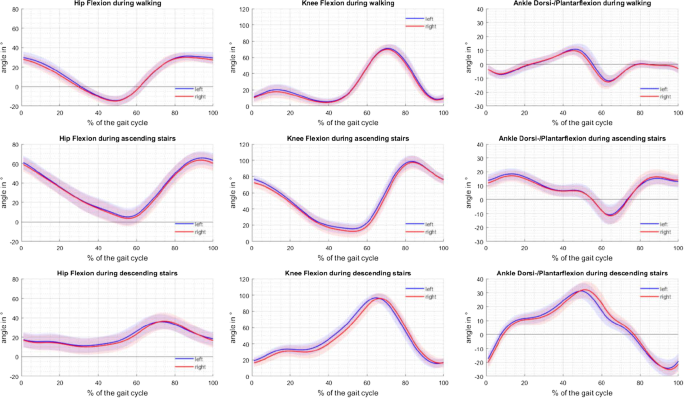Well, now, y’all probably wonderin’ what this “walking asymmetry” thing is all about. Don’t worry, I’ll explain it plain and simple, just like I would to my neighbor down the road. Walking asymmetry, you see, is when one leg moves a bit different from the other when you walk. Like, one leg might be a bit faster or slower than the other. You might not even notice it unless someone points it out or you see it on a fancy chart, like that one folks talk about with all them gadgets and phones nowadays.
What’s this Walking Asymmetry Chart then?
Well, this chart thingy is just a way to measure how much difference there is between the left and right sides of your walk. You know, folks always say “one leg’s stronger than the other,” and that’s true for most of us. That chart just shows exactly how much one side might be different from the other. It’s like when you’re tryin’ to bake bread, and one loaf rises higher than the other. That’s kinda what this chart’s measuring, but it’s for your legs and how they move when you walk.
What Causes Walking Asymmetry?
Now, don’t go thinkin’ there’s somethin’ wrong with you if your legs don’t move the same. No sir, walking asymmetry is natural for most folks. See, a lot of us got a “dominant” leg – that’s the one we tend to step forward with more often, or the one that’s a bit stronger. Like, I always seem to step with my right leg first when I’m walkin’ down to the creek. And that can cause a little difference in the way the two legs move. It’s just how our bodies work, and there ain’t much to worry about unless it starts hurtin’ or makes it hard to walk.
How Do You Know If You Got Too Much Asymmetry?
Now, if you’re lookin’ at one of them fancy charts and see your walking asymmetry goin’ higher than 10 or 15%, it might be worth gettin’ checked out by a doctor. See, healthy young folks usually got a difference of 5 to 15% between their legs. But as you get older, that number might go up a little, sometimes even closer to 20%. It’s all right if it’s small, but if it gets bigger, it might start affectin’ how you move around or cause a bit of pain. If you feel any of that, it’s a good idea to get someone to take a look at it.
How Do We Measure This Asymmetry, Anyway?
Now, don’t be thinkin’ you gotta go to a fancy doctor every time you want to check this out. These days, even your phone can help with that! Yep, the iPhone got this fancy Health app that uses sensors to measure how your feet move. You just stick your phone in your pocket, and it’ll track the time one foot moves faster or slower than the other. That’s how it figures out your walking asymmetry. If you got a good phone, it’ll even make a nice little graph for you to look at.
Why Should I Care About Walking Asymmetry?

Well, you might not care right now, but it’s good to know if there’s a problem down the line. See, if one leg’s always doin’ more work than the other, it might wear out quicker. Could cause pain in your knees, hips, or even your back. Sometimes, the asymmetry could be a sign of somethin’ else, like a past injury or muscle weakness. So, even if you ain’t feelin’ no pain, it’s smart to keep track of how you’re walkin’ every now and then.
What Happens If I Got Too Much Asymmetry?
Now, let me tell ya, if you’ve got too much difference between your legs, you might start to feel like you’re draggin’ one leg behind or that one side is takin’ all the load. That could lead to aches and pains, and over time, you might even notice a bit of limp. In more serious cases, it can mess with your balance, too, and that’s never good, especially as we get older. But, don’t go panicin’! If you notice any of this, just get yourself checked out by a doctor or a physical therapist. They can help you figure out what’s goin’ on and get you back to walkin’ like you used to.
What Can Be Done About It?
Now, don’t think it’s all bad news. There’s plenty you can do if you find out your walking asymmetry’s a little too much. A good ol’ physical therapist might help you with exercises to strengthen the weaker leg or balance things out. Sometimes, just stretchin’ or workin’ on your posture can make a big difference. And if it’s an old injury that’s messin’ with your walk, some treatment and rest could fix that right up.
In Conclusion
So, to wrap it up, walking asymmetry ain’t somethin’ to be afraid of, but it’s good to know how much difference there is between your legs. If it’s a little bit, you’re probably fine, but if it’s more than that, you might want to pay attention. It could mean somethin’ about your health, and if you notice any pain or discomfort, don’t be shy – get it checked out. Take care of yourself, and keep on walkin’ strong!
Tags:[Walking Asymmetry, Walking Gait Analysis, iPhone Health App, Walking Speed, Step Length, Gait Symmetry, Physical Therapy, Mobility Metrics]
